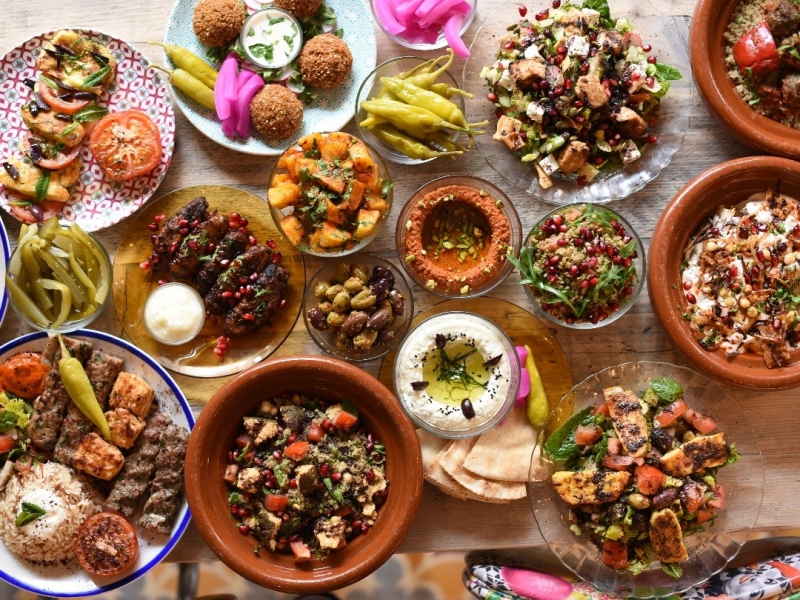As empires rose and fell, wars came and went, and waves of refugees trickled in to stay over the course of centuries, Lebanon’s already sophisticated food landscape expanded. A meal today might bring the culinary traditions of Syria, Palestine, Morocco, Armenia, Turkey, and beyond.
Speaking about its history Lebanon has been ruled by foreign powers that have influenced the types of food the Lebanese ate. From 1516 to 1918, the Ottoman Turks controlled Lebanon and introduced a variety of foods that have become staples in the Lebanese diet, including olive oil, fresh bread, baklava (a sweet pastry dessert), laban (homemade yogurt), stuffed vegetables, and a variety of nuts. The Ottomans also increased the popularity of lamb in their meals. After the Ottomans were defeated in World War I (1914–1918), France took control of Lebanon until 1946. During this time, the French introduced some of their treats such as flan, a caramel custard dessert dating back to the 1500s, and buttery croissants.
With those influences in mind, here’s a look at the dishes that define the delicious Lebanese culinary landscape!
Hummus
Hummus needs no introduction. This internationally popular, beige-colored spread is traditionally made with mashed chickpeas, tahini sesame paste, lemon juice, and garlic. People across the world love hummus for its tangy flavor and the fact that it is filled with nutrients. Rich, yet light on the palate, it can be eaten with anything from pita bread to grilled eggplant and vegetable sticks, enjoyable as an appetizer or even as a quick snack. It’s best to order hummus to share and eat it with pita bread, it makes for an amazing appetizer! Even today, not much is known about its origins, although the earliest mention of hummus dates back to 13th-century Egypt.


Baba Ghanoush
When in Lebanon, you will probably get asked that famous question “Baba ghanoush or Hummus?”. If you like hummus, then this dish is a must-try. It’s a dip that’s served with pita bread and drizzled with olive oil. The main difference is that baba ghanoush is made from eggplant instead of chickpeas, and sometimes it’s topped with pomegranate.


Falafel
If you haven’t tried falafel yet, you’re living under a rock. These deep fried balls of deliciousness is made from ground chickpeas and fava beans, along with assorted herbs and spices. The main reason why this dish preferred all around is the world is not only because of its taste, but also because it is one of the healthiest cholesterol-free vegan/vegetarian dishes, relatively low in fat and calories. Fava beans can be used instead of chickpeas, while the mixture is typically flavored with parsley, coriander, cumin, and onions. Today, falafel fritters are most commonly enjoyed in pita or lafa flatbread sandwiches, topped with fresh or pickled vegetables, and coated either in hummus paste, tahini dip, or a zesty, garlic-flavored yogurt sauce.


Shawarma
Shawarma is Middle East’s favorite fast food. The name comes from the Turkish word çevirme which means “turning,” and where you have some deeply marinated layers of beef, lamb or chicken stacked on a vertical spit and slowly turning against a soft grilling fire for hours. The meat is then shredded and wrapped in a pita bread with garlic paste (chicken shawarma) or Tahini sauce (beef shawarma) and other goodies such as grilled tomatoes, chopped parsley, french fries, grilled onions, and salted Lebanese pickles. It’s a treat to your taste buds!


Fattoush
Fattoush is a traditional Lebanese salad that is considered one of the main dishes of Lebanese cuisine. Pita bread is torn or cut into small bite-sized pieces, then toasted, grilled, or fried. It is then mixed with a variety of vegetables such as lettuce, radish, crunchy cucumbers, cherry tomatoes or regular tomatoes, peppers, onions, and (occasionally) garlic. The final touch to this authentic salad is the dressing, usually made with olive oil, lemon juice, and pomegranate syrup. The key ingredient, next to the crunchy pita bread, is sumac – a spice commonly used in the Levantine area. This is a great salad to share with others, making the dining experience a way of bringing people together and bonding over the mouth-watering cuisine.


Manakeesh
If you love pizza, this is the Lebanese version of it. It is made of made of flatbread, which is covered with a variety of toppings such as meat, zaatar, cheese, tomatoes, cucumbers, fresh mint leaves, and olives. Although it is a recent addition to the Lebanese culinary heritage, but it quickly became one of the most popular dishes due to its flavors, low price, and the ease of preparation.


Kibbeh
This is another Lebanese classic you will usually find as a part of a mezze spread. Prepared with a tantalizing mix of ground meat, herbs and spices, it is a unique mixture of soaked bulgur wheat and lamb meat. The specialty of the dish is the use of fresh ground meat, but it is so flavorful that you will never find out you are eating raw meat. It is drizzled with mint and olive oil and served along with bread and tomatoes. Fragrantly spiced and eaten as a snack for casual or celebratory meals, Kibbeh can be raw, baked, fried, stuffed, or prepared in a vegetarian version, stuffed with potatoes, pumpkins, and tomatoes.


Baklava
Baklava is one of the popular desserts made from phyllo dough, nuts (cashews, almonds, pine nuts, walnut and pistachios) and steeped in syrup of rose water, orange blossom water, sugar and water. Its flaky, buttery crust layers melt in your mouth, intertwining with the nutty and sweet layers within. Baklava’s sticky, warm pleasures will leave you in sugar-coated reverie.


While Lebanese food has undergone many changes over the years it has always maintained a strong connection with its roots. If you are looking to try one of the world’s freshest, healthiest and most delicious cultural foods, Lebanese Cuisine is the real deal for you!
Click here to read about Persian Cuisine!
You can follow us on Instagram at @onhisowntrip

